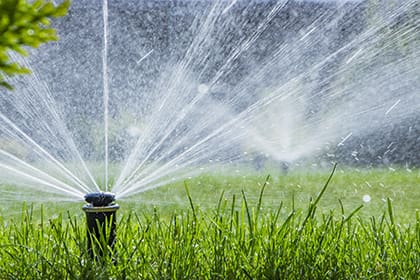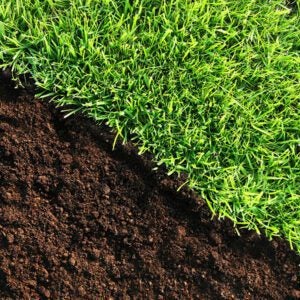

Optimizing Water-use Efficiency, Quenches Thirsty Turf, Reduces Irrigation
Optimizing Water-use Efficiency, Quenches Thirsty Turf, Reduces Irrigation
Growing healthy turf grass throughout the West is always a challenge. Even when rainfall is plentiful, extreme heat and finicky turf grass varieties create headaches for golf course and turf managers, making it hard to maintain lush, durable turf within a limited budget.
Brad Baker, a Wilbur-Ellis turf expert and California pest control advisor, helps turf managers find solutions to this ongoing challenge. He discusses their goals and then evaluates each situation, taking note of cultural practices, analyzing the chemistry of irrigation water, observing irrigation practices, monitoring soil structure and initiating soil diagnostics.
He pays specific attention to the salt load and soil pH.
Baker then creates individualized plans to help turf managers get the most out of inputs and irrigation, resulting in a vigorous, long-lasting turf.
The characteristic he believes unites all turf varieties is the importance of a healthy root system. The roots are the lifeline of the plant. They take up water and nutrients and give turf strength, stability and vigor.
“A healthy root system reaches far into the soil. It is dense with lots of feeder roots,” said Baker. “This expansive system allows the grasses to withstand excessive traffic, insufficient watering practices, and find nutrients in the soil more easily. A robust root system also is a principal factor in the turf’s ability to maximize soil moisture uptake.”
But how does one improve the water-uptake efficiency of turf?

Good fertility drives the development of healthy roots.
“Establishing a good fertility program is a key step in root zone development because it promotes proper root growth, boosts plant health, and prepares your turf to make full use of the water that you apply. Soil diagnostics ismy starting point for setting up a nutrition program that contributes to overall turf health,” explained Baker.
Including humic acid in the nutritional program is one way Baker’s programs enhance the root zone and increase water retention and uptake. Humic acid adds carbon and increases the cation exchange capacity (CEC) of the soil, enhancing nutrient availability and allowing grasses to put more energy into growing rather than seeking out nutrients and water.
A humic acid, like PURIC® SALUTE®, may aid soil bacteria’s capacity to consume excess organic matter, chelating micronutrients, and opening up the soil profile so water can travel evenly through the root zone. It also helps decrease the high sodium levels of certain soils and overall makes nutrients more available for root uptake.
In addition to humic acid, Baker also uses soil biologicals to boost the effectiveness of nutrient applications.
“Biologicals have the potential to positively affect turfgrass production and water savings. They supply more organic options for turf managers looking to boost the effectiveness of their nutrient applications,” said Baker.
NUTRIO UNLOCK® is a liquid biological catalyst that enhances root architecture. The specific beneficial microbes in this product boost soil biodiversity and help maximize nutrient availability in the soil to enhance root growth and improve soil structure, which may lead to improvements in the overall moisture-holding capacity of the turf.
“Once we have that increased root mass using nutrients and we’re holding more moisture in the plant as a result of healthier soil, we can use less water overall when irrigating,” said Baker.


Keeping the root zone wet, with less water.
Wetting agents are another tool Baker may turn to for help making the most of irrigation and improving the soil moisture profile.
“Some soils tend to get what we call water fingers where the water will travel down the path of least resistance, leaving sections of the root zone dry,” said Baker. “As a result, we must irrigate more to put enough moisture throughout the entire profile. A wetting agent will allow water to move evenly through the profile.
The wetting agents overcome these challenges even if the soil profile is clogged with fine particles or waxy organic matter that resists wetting. The wetting agents allow moisture to move evenly through the soil rather than permeating only the looser areas or the soil that may still be wet from the last irrigation. Some wetting agents also hold water longer in the soil, while others simply move water deeper into the soil profile to feed warm-season grasses that have a deeper root structure. All can help enhance the water-holding capacity of the soil, reducing the amount of irrigation water needed.
“One of the mistakes that I see managers make is that they don’t put down enough irrigation to hydrate further down in the soil. Once the organic matter in the soil dries out, it’s difficult to re-wet. Wetting agents help us overcome this challenge,” explained Baker.
“If we can take the water fingers out and evenly distribute soil moisture down four inches, in 7 minutes vs. 10 minutes, for example, we’re saving roughly 30% on irrigation. That’s significant savings,” Baker pointed out.
“Wilbur-Ellis has the tools and support needed to diagnose the challenges turf managers have and the flexibility to provide them with the best products and solutions for their situations,” Baker reflected. “I like being able to solve problems and help my customers meet their goals.”
The team of experts at Wilbur-Ellis is proud to help golf course and turf managers navigate the challenges of growing healthy turf and optimizing inputs. Reach out to your local Wilbur-Ellis location for help finding turf solutions that are right for you. Find a location today.

